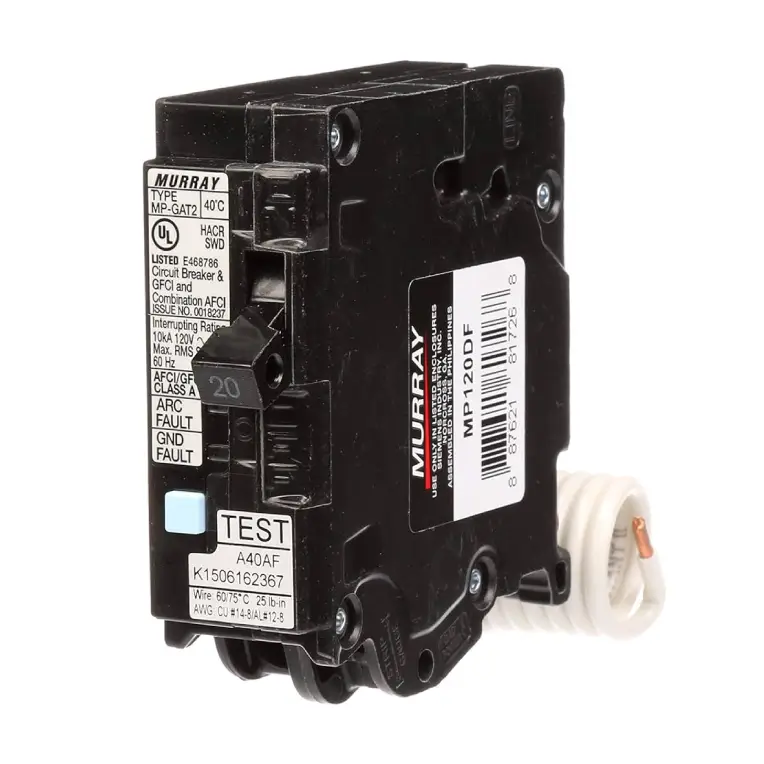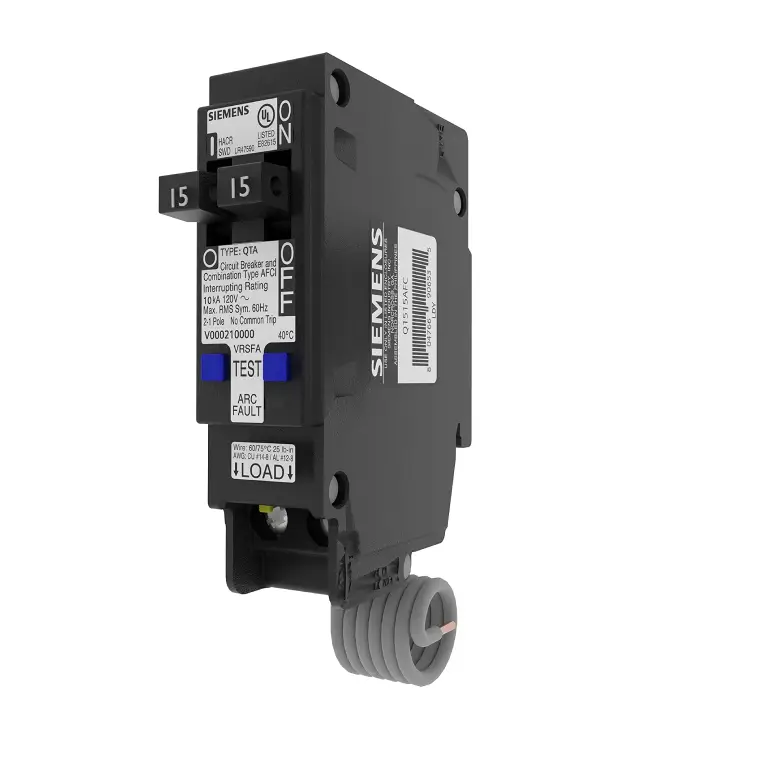AFCI Circuit Breaker
An Arc-Fault Circuit Interrupter (AFCI) is a type of circuit breaker designed to detect and interrupt electrical arcing faults. These faults can occur due to loose connections, damaged insulation, or other wiring issues, and they are a leading cause of residential fires.
Get AFCI Circuit Breaker to Delight Your Customers
AFCI circuit breakers are a vital safety component for modern homes. By proactively addressing potential electrical hazards, you can not only protect your customers’ property but also enhance their peace of mind.

AFCI vs GFCI Circuit Breaker
| Feature | GFCI | AFCI |
|---|---|---|
| Primary Protection | Electrical shock | Electrical fire |
| Detection Method | Monitors current imbalance | Detects electrical arcs |
| Typical Installation | Wet areas (bathrooms, kitchens, outdoors) | Bedrooms, living rooms, other interior areas |
Combination AFCI and GFCI Circuit Breaker
A combination AFCI/GFCI circuit breaker is a powerful tool for protecting your home from both electrical shock and electrical fires. This single device combines the features of both an Arc-Fault Circuit Interrupter (AFCI) and a Ground Fault Circuit Interrupter (GFCI), providing comprehensive electrical safety.


Square D Dual Function AFCI/GFCI Circuit Breaker
Square D offers a variety of dual-function AFCI/GFCI circuit breakers designed to provide comprehensive electrical safety in your home. These breakers combine the features of both Arc-Fault Circuit Interrupters (AFCI) and Ground Fault Circuit Interrupters (GFCI) into a single device.
Tandem AFCI Circuit Breaker
Tandem AFCI circuit breaker is a type of breaker that allows you to power two separate circuits from a single breaker slot in your electrical panel. This is a space-saving solution, especially in older homes with limited panel space.

AFCI Circuit Breaker FAQs
what is AFCI circuit breaker
An Arc-Fault Circuit Interrupter (AFCI) is a type of circuit breaker designed to detect and interrupt electrical arcing faults.
These faults can occur due to loose connections, damaged insulation, or other wiring issues, and they are a leading cause of residential fires.
what is a combination AFCI circuit breaker?
A combination AFCI circuit breaker is a type of electrical circuit breaker that provides both arc-fault and ground-fault protection in a single unit.
Arc-Fault Protection:
- Detects and interrupts dangerous electrical arcs caused by faulty wiring, loose connections, or damaged insulation.
- Helps prevent electrical fires.
Ground-Fault Protection:
- Monitors the balance between incoming and outgoing current.
- Detects a ground fault (a current leak to the ground) and quickly interrupts the power.
- Helps prevent electrical shock.
Benefits of Combination AFCI/GFCI Breakers:
- Comprehensive Protection: Offers protection against both electrical shock and electrical fires.
- Code Compliance: Meets or exceeds electrical code requirements in many jurisdictions.
- Convenience: Combines two essential safety features into a single device.
- Peace of Mind: Knowing your home is protected from these common electrical hazards.
Where to Install:
While specific installation requirements may vary based on local electrical codes, combination AFCI/GFCI breakers are often recommended for:
- Kitchens
- Bathrooms
- Laundry Rooms
- Other high-risk areas
Important Considerations:
- Professional Installation: Always hire a licensed electrician to ensure proper installation.
- Regular Testing: Periodically test your GFCI/AFCI breakers to verify their functionality.
- Compatibility: Ensure compatibility with your home’s electrical system.
By incorporating combination AFCI/GFCI circuit breakers into your home’s electrical system, you can significantly reduce the risk of electrical accidents and fires.
how does AFCI circuit breaker work?
AFCI breakers use advanced electronics to monitor the electrical current flowing through a circuit.
They can detect the unique electrical signature of an arcing fault, which is different from the normal flow of current. When an arcing fault is detected, the AFCI quickly interrupts the power to the circuit, preventing a fire from starting.
Here’s a more detailed explanation of how AFCIs work:
- Current Monitoring: AFCIs continuously monitor the electrical current flowing through the circuit. They analyze the waveform of the current to detect any anomalies.
- Arc Fault Detection: An arcing fault produces a unique electrical signature, characterized by rapid fluctuations in voltage and current. AFCIs are designed to recognize these patterns.
- Rapid Response: Once an AFCI detects an arcing fault, it quickly interrupts the power supply to the circuit.This rapid response helps to prevent the fire from spreading.
what are Types of AFCIs?
There are two primary types of AFCI circuit breakers:
1. Branch/Feeder AFCI:
- Installed at the origin of a branch circuit or feeder, typically in the electrical panel.
- Detects arcing faults between the hot and neutral wires (parallel arcing).
2. Combination AFCI:
- Offers both parallel and series arc fault protection.
- Detects arcing faults between the hot and neutral wires, as well as arcing faults that may occur within electrical devices or cords (series arcing).
- Provides more comprehensive protection than branch/feeder AFCIs.
It’s important to note that the specific types of AFCIs available and their suitability for different applications may vary depending on local electrical codes and regulations. Always consult with a qualified electrician to determine the best type of AFCI for your specific needs.
how to install a AFCI circuit breaker?
Disclaimer: Installing an AFCI breaker requires electrical expertise. If you’re unsure, consult a licensed electrician.
Here’s a general guide on how to install an AFCI circuit breaker:
Materials Needed:
- AFCI circuit breaker (compatible with your panel)
- Screwdriver
- Voltage tester
Steps:
Turn Off Power:
- Turn off the main breaker to completely de-energize the electrical panel.
Remove Panel Cover:
- Remove the panel cover to access the circuit breakers and wiring.
Identify the Circuit:
- Determine the circuit you want to protect with the AFCI breaker.
Remove Old Breaker:
- Carefully remove the old breaker from its slot.
Connect Wires to the AFCI Breaker:
- Connect the hot wire (usually black) to the breaker’s hot terminal.
- Connect the neutral wire (usually white) to the breaker’s neutral terminal or the neutral bus bar, depending on the breaker type.
Install the AFCI Breaker:
- Carefully snap the AFCI breaker into the slot in the panel. Ensure it’s securely fastened.
Replace Panel Cover:
- Reinstall the panel cover, making sure it’s securely fastened.
Turn On Power:
- Turn on the main breaker.
Test the AFCI Breaker:
- Most AFCI breakers have a test button. Press the button to ensure the breaker trips as expected.
Important Considerations:
- Compatibility: Ensure the AFCI breaker is compatible with your electrical panel and local electrical codes.
- Wiring: Follow the specific wiring instructions provided with the AFCI breaker.
- Safety: Always prioritize safety. If you’re unsure about any step, consult a licensed electrician.
- Local Codes: Adhere to local electrical codes and regulations.
Visual Guide:
For a more detailed visual guide, you can refer to online resources or consult a professional electrician.
Remember, electrical work can be dangerous. If you’re not confident in your ability to install an AFCI breaker, it’s best to hire a qualified electrician to do the job.